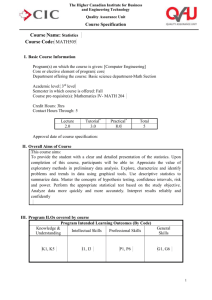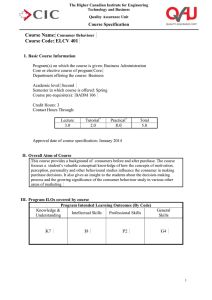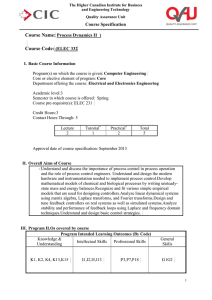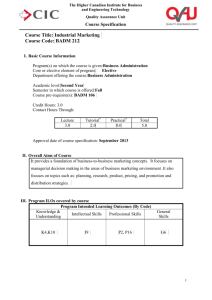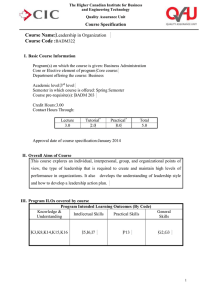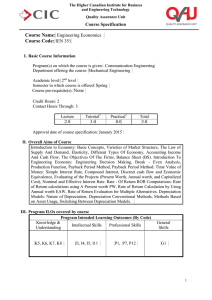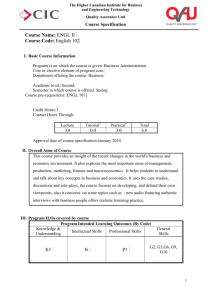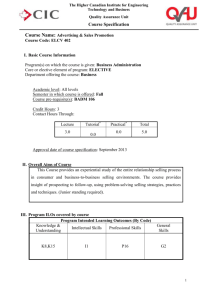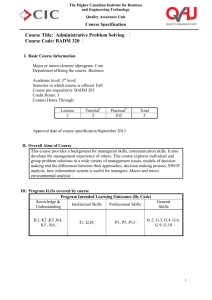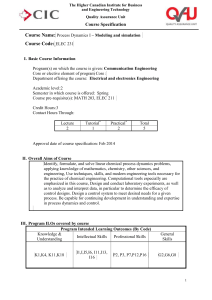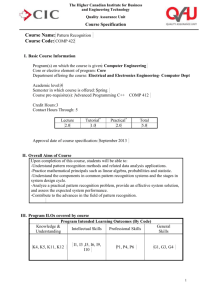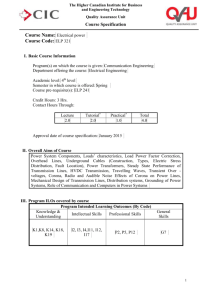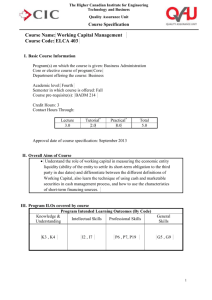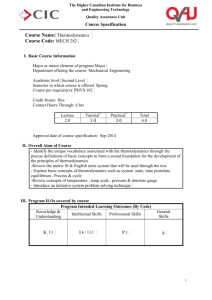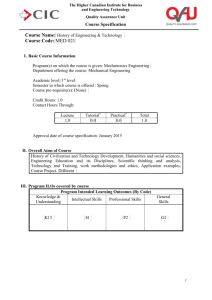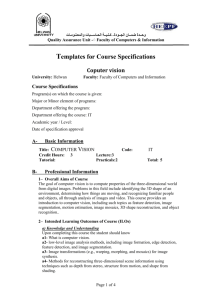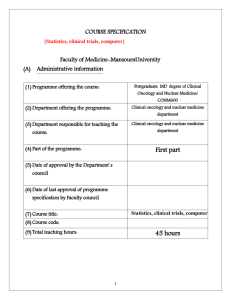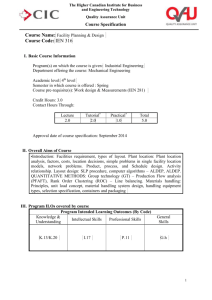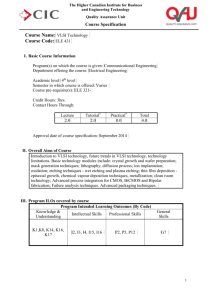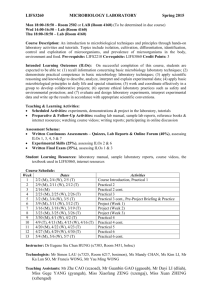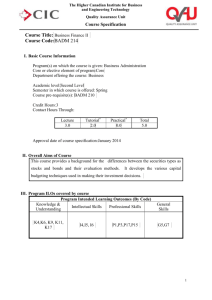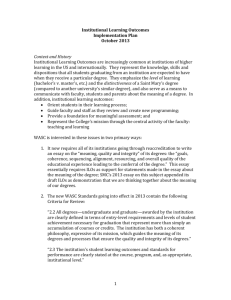COURSE TITLE (COURSE CODE)
advertisement
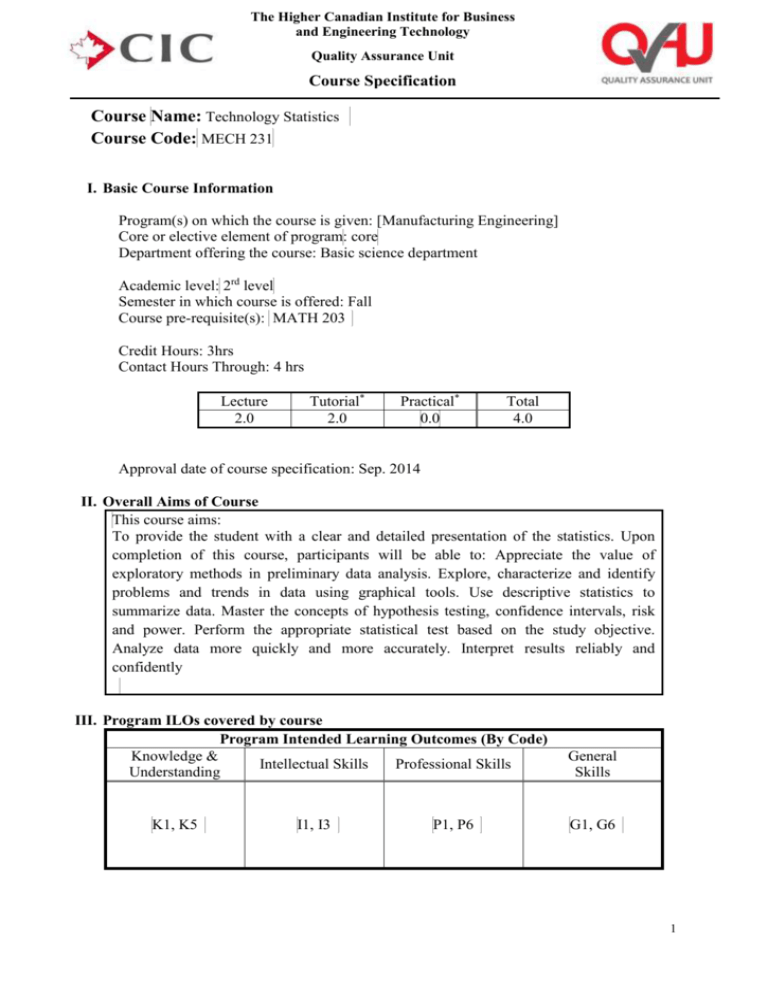
The Higher Canadian Institute for Business and Engineering Technology Quality Assurance Unit Course Specification Course Name: Technology Statistics Course Code: MECH 231 I. Basic Course Information Program(s) on which the course is given: [Manufacturing Engineering] Core or elective element of program: core Department offering the course: Basic science department Academic level: 2rd level Semester in which course is offered: Fall Course pre-requisite(s): MATH 203 Credit Hours: 3hrs Contact Hours Through: 4 hrs Lecture 2.0 Tutorial* 2.0 Practical* 0.0 Total 4.0 Approval date of course specification: Sep. 2014 II. Overall Aims of Course This course aims: To provide the student with a clear and detailed presentation of the statistics. Upon completion of this course, participants will be able to: Appreciate the value of exploratory methods in preliminary data analysis. Explore, characterize and identify problems and trends in data using graphical tools. Use descriptive statistics to summarize data. Master the concepts of hypothesis testing, confidence intervals, risk and power. Perform the appropriate statistical test based on the study objective. Analyze data more quickly and more accurately. Interpret results reliably and confidently III. Program ILOs covered by course Program Intended Learning Outcomes (By Code) Knowledge & Intellectual Skills Professional Skills Understanding K1, K5 I1, I3 P1, P6 General Skills G1, G6 1 The Higher Canadian Institute for Business and Engineering Technology Quality Assurance Unit Course Specification IV. Intended Learning Outcomes of Course (ILOs) a. Knowledge and Understanding On completing the course, students should be able to: [k1. Classify the different rules of probabilities k2. Recognize the different methods used to solve joint probability k3. Define the Probability density function k4. Discuss the methods of pdf function k5. Explain the Uniform and Gaussian distribution ] b. Intellectual/Cognitive Skills On completing the course, students should be able to :i1. Categorize the problems probabilities i2. Develop the idea of joint and Gaussian distribution . c. Practical/Professional Skills On completing the course, students should be able to: p1. Solve a problems using the appropriate methods. p2. Apply numerical methods p3. Compute power from Pdf signals p4. Apply and analyze the measuring instruments, workshops and laboratory equipment to design experiments p5. Apply different tests to study the convergence of sequences and series of numbers. d. General and Transferable Skills On completing the course, students should be able to :G1. React with each other through brain storming questions. G2. Use the available resources effectively. V. Course Matrix Contents Main Topics / Chapters 1234567- Duration (Weeks) Probabilities Theory Joint Probabilities Probability density function Uniform Distribution Gaussian Distribution 2 2 3 2 3 Net Teaching Weeks 12 Course ILOs Covered by Topic (By ILO Code) K&U I.S. P.S. G.S. k1 i1 p1 g1, g2 k2 i1 p1 g1, g2 k3 i1 p1, p2 g1, g2 k4, k5 i1 p1 g1, g2 k5 p3, p4 g1, g2 i2 p5 g1, g2 2 The Higher Canadian Institute for Business and Engineering Technology Quality Assurance Unit Course Specification VI. Course Weekly Detailed Topics / hours / ILOs Week No. 1 2 3 4 5 6 7 8 9 10 11 12 13 14 15 Total Hours Sub-Topics Measures of Location Measures of variation 4 Possibilities and Probabilities Rules of Probabilities Probability Distributions Probability Distributions Normal Distributions Normal Distributions Test of Hypotheses Test of Hypotheses Regression Correlation Tests) Revision Total Teaching Hours Contact Hours Theoretical Practical Hours Hours* 2 4 2 2 4 4 4 4 Midterm Exam 4 4 4 4 4 4 4 Final Exam 52 2 2 2 2 2 2 2 2 2 2 2 2 2 2 2 2 2 2 2 2 2 2 26 24 Teaching/Learning Method Lectures & Seminars Tutorials Computer lab Sessions Practical lab Work Reading Materials Web-site Searches Research & Reporting Problem Solving / Problem-based Learning Projects Independent Work Group Work Case Studies Presentations Simulation Analysis Selected Method VII. Teaching and Learning Methods Course ILOs Covered by Method (By ILO Code) √ √ All All Intellectual Skills All All √ √ All All All All All All g2 g2 √ All All All g2 K&U Professional Skills All All General Skills All All Others (Specify): 3 The Higher Canadian Institute for Business and Engineering Technology Quality Assurance Unit Course Specification Selected Method VIII. Assessment Methods, Schedule and Grade Distribution Course ILOs Covered by Method (By ILO Code) Assessment Method K&U I.S. P.S. G.S. Midterm Exam Final Exam Quizzes Course Work Report Writing Case Study Analysis Oral Presentations Practical Group Project Individual Project √ √ √ √ k1, k2, k4 All k1, k2, k3 All i1 All i1 All p1, p2 All p1 All g2 g2 All Assessment Weight / Percentage Week No. 20% 50% 10% 20% 7 15 3, 5, 9 2, …, 13 Others (Specify): IX. List of References Essential Text Books Course notes Recommended books Periodicals, Web sites, etc … Statistics for Engineers and Scientists - Textbook ISBN #: 978-0-07-110222-3. Lecture Notes E. Swokowski, M. Olinick, D. Pence, Calculus, PWS Publishing Company, Boston, 1994. Mary Attenborough, Engineering Mathematics, McGraw-Hill Book Company Europe, 1994. Antony Croft, Robert Davison, Engineering Mathematics A modern Foundation for electrical Electronic & Control Engineering, Addison-Wasley-Publishing Company, 1992. www.libgen.org X. Facilities required for teaching and learning Computer-Data show. Course coordinator: Dr Assem Tharwat Head of Department: Associate Professor Dr.Hamdy hussein Date: September 2014 4
